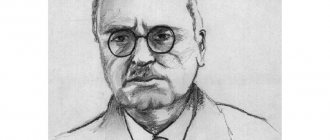In the system of modern international classification of diseases, there is no such concept as “psychopathy” - it was replaced by the term “personality disorder”. Experts believe that this definition is more suitable to describe this disease, which is characterized by persistent personality deformation, distortions of internal perception and thinking. Psychopathy is less common in men than in women. However, in representatives of the stronger sex, the pathology manifests itself at an earlier age, is more severe and is quite difficult to treat. The complex therapy offered by the doctors of the Leto mental health center makes it possible to achieve stable, long-term remission and socialization of the patient.
Causes of psychopathy in men
Until recently, experts were convinced that the main role in the etiology of the disease belongs to the hereditary factor. However, during long-term clinical studies this theory was not confirmed. Most likely, from an early age, children see an example of their parents’ behavior and subconsciously copy this manner of communication.
In addition, the causes of the disease may be:
- severe psychological trauma suffered at any age;
- damage to the central nervous system (neoplastic tumors in the brain, toxic or hepatic encephalopathy, acute or chronic hypoxia, consequences of stroke, etc.);
- long-term stressful situation associated with conflict in the family or at work, financial troubles, health problems, etc.
Causes of psychopathy
The factors leading to the development of personality deviations are very diverse.
Important psychiatrists include:
- Heredity. The manifestation of psychopathic problems in the family is a prerequisite for their occurrence in close relatives.
- Pathology of pregnancy, complicated childbirth and painful childhood.
- Unfavorable environment of upbringing and life with the experience of psychophysical violence, tyranny, inappropriate behavior of persons (in places of deprivation of liberty), on whom the psychopath was dependent.
- Transference of psychologically traumatic situations: deaths, disasters, accidents, wars and other factors that have a destructive impact on the psyche.
Clinical picture
Personality disorders are not accompanied by pronounced neurological symptoms, with the exception of cases when the cause of the pathology is organic brain damage. Therefore, the diagnosis is made based on the characteristics of a person’s behavior, socialization skills, and interpersonal relationships.
Depending on the clinical manifestations, there are several forms of psychopathy in men:
- asthenic;
- anancaste;
- schizoid;
- paranoid;
- dissocial;
- emotionally unstable;
- hysterical.
What is psychopathy
Psychopathic disorder is a painful variant of human behavior, often a sociopath, expressed in the excessive manifestation of negative character traits.
Most often he stands out:
- Heartlessness, rudeness, rudeness.
- A complete lack of sensitivity to other people's problems and pain.
- Reluctance to consider the opinions of others.
- Antisocial behavior with violent tendencies.
- The feeling of being right in situations where there is clear evidence to the contrary.
In the opposite type of disorder, painfully excessive:
- Anxiety.
- Indecisiveness.
- Closedness.
- Impressionability and self-deprecation.
In psychiatry, this type of behavior is not considered a disease in the literal sense. It is rather a social deviation with painful traits that requires specific correction. At the same time, psychiatrists have to deal with complex cases of this disorder.
Asthenic personality disorder
The main symptoms of this form of the disease include:
- rapid exhaustion;
- weakness;
- irritability;
- shyness and timidity;
- apathy;
- general depressed state.
Men suffering from this type of psychopathy are characterized by impressionability and a tendency to introspection. Characteristic is a feeling of one’s own inferiority, insolvency; the future is always seen in a pessimistic light. They do not believe in their strength, are afraid of any difficulties and make every effort to avoid them.
As a rule, they take a passive position, are entirely dependent on the opinions of others, endure all insults without complaint, and unquestioningly carry out instructions. A tendency toward hypochondria is noted; the patient listens to all internal sensations. And even a slight deviation from the norm is perceived as a severe pathology.
Reasons for the development of psychopathy
Psychopathic disorder can develop as a result of both internal and external factors.
There are 3 main groups of psychopathy due to its occurrence:
- Nuclear (constitutional). Psychopathy is inherited or occurs as a result of damage to the fetus, before birth. The influence of the environment is also important, but it influences the formation of the defect to a lesser extent.
- Organic (mosaic). The onset of the disease is caused by cerebral-organic insufficiency. The role of external factors depends on the degree of this anomaly: the less pronounced the deficiency, the more significant they are.
- Edge and post-processual. Pathology arises as a result of interaction with the environment. The appearance of psychopathy is influenced by psychogenic, situational, reactive and neurotic reasons. The role of biological factors in the formation of the disorder is insignificant or completely absent.
Important! The groups of causes that give rise to psychopathic disorders do not affect the type of pathology and its characteristic symptoms. In most cases, the etiology of psychopathy is mixed.
Schizoid psychopathic disorder
In terms of external signs, some experts compare this variant of pathology with autism, since men suffering from this disease are withdrawn, very sensitive to their personal space, and prefer loneliness. They note emotional coldness and aloofness, and very often these traits are combined with a passion for reading, nature, and culture.
At the same time, the patient can experience troubles in the family, at work, and in his personal life very painfully. He is unable to free himself from memories of failures, insults addressed to him, or any shameful situations. Patients are very vulnerable, vulnerable, but they skillfully hide self-doubt and resentment behind external coldness and indifference. But at the same time, they do not take into account the opinions of others, they like to interfere in other people’s affairs, and give inappropriate advice.
Diagnostics
The examination stage requires some time from the doctors of our clinic.
To make an accurate diagnosis, they use:
- A conversation in the form of a dialogue, during which all the nuances of the person being examined are gradually clarified.
- Conversation with relatives.
- Dynamic monitoring of the patient.
A psychologist is involved in the diagnostic process, supplementing medical data with test methods and a special PSL-R questionnaire. He also makes additional recommendations for treatment.
When diagnosing, it is important not only to establish the psychopathic type, but also the stage of the process:
- Compensated.
- Subcompensated.
- Decompensated.
These data must be taken into account when prescribing treatment.
Types of psychopathy
Modern views on the problem have led to the formation of multiple classifications. Let's consider the most applicable one in domestic practice. It is based on the theoretical views and practical developments of Russian scientists, followers of P.B Gannushkin.
In the clinic of psychopathy, the following forms are distinguished:
- Asthenic – with characteristic fearfulness, psychophysical weakness, vegetative disorders. Mimosa type.
- Psychasthenic – manifested by excessive indecision, introspection, anxiety and fear of responsibility.
- Schizoid. The bearer of this psychopathic portrait is closed, self-absorbed, prone to intellectual activities, striving to direct all his talents to self-satisfaction. Knowing his worth, absolutely indifferent to others, capable of self-destruction and unemotional harm to other people.
- Paranoid. The patient is a stuck, stubborn and touchy bearer of overvalued ideas, often of a destructive nature, who pursues their implementation to the end.
- Epileptoid. Has excitability, rage and anger of extreme strength. Doesn't forgive anyone's mistakes and is vengeful. The idea of vengeance can be carried around for decades unnoticed by others.
- Hysterical. Actor type. Obsessed with himself and demands the attention of others. He often lies to please himself and to get what he wants. Prone to taking psychoactive substances.
- Cycloid. A client with a sharply changing emotional background. From depression with depression he falls into the status of hyperthymic. In both cases there is a tendency towards socially pathological behavior.
Paranoid psychopathy
The clinical picture is dominated by suspicion, which takes precedence over logic and reason. Such men are pathologically neat and conscientious, intolerant of injustice. But their horizons are very narrow, their interests are limited, there is no desire for self-development, no desire to achieve any goals.
Even in words or actions accidentally thrown by someone, a person sees a hidden meaning and threat. Distrust is typical, which very quickly develops into suspicion. The patient is sure that they are treating him without due respect and want to insult him. Without treatment, the disease usually progresses with the formation of delusional ideas involving persecution, jealousy, etc.
Types of psychopathy, signs and symptoms, stages
Precursors of a psychopathic state - personality accentuations - occur on average in 10% of the population. It is these individuals who most often become psycho-sociopaths. The percentage of patients suffering from this disorder among all people is quite high. According to statistics, it is within 1-2%. Individuals with aggressive types of the disorder pose a danger to society.
The main signs of this type of psychopathy:
- Extreme degree of egocentrism.
- Cruelty reaching the point of sadism.
- Unceremoniousness and unwillingness to take into account someone's opinion.
- Despotism, a painful desire for power and control of other people.
- A sharp decrease or absence of emotional experiences.
It is this psychotype that is most often associated with crime. Men are more prone to physical forms of expression of psychopathic deviations, while among women psychological ones dominate. The psycho-social treatment of such persons is a particularly responsible matter.
Dissocial disorder
There are no prohibitions or restrictions for men with dissocial psychopathy. They live without caring about family, relatives, or their future, never finish what they start, prefer easy income (they often note an addiction to gambling), and strive to satisfy their financial needs at the expense of others.
Sometimes, by obeying the demands of family members, a man can find a well-paid job and do all the necessary things, but as soon as control is weakened, everything returns to normal. Patients easily become involved in antisocial companies, often use alcohol and drugs, and commit minor offenses.
Treatment of psychopathological syndrome
The psychopathic condition is treated with the help of nootropics, symptomatic drug therapy and psychotherapeutic techniques.
Drug treatment
Treatment of psychopathic syndrome is carried out with the help of nootropics and psychostimulants. Supportive symptomatic therapy is also relevant.
| Drug groups | Effect on psychopathy | Examples of funds |
| Nootropics | Normalize cerebral circulation, improve memory and intelligence. They are used for organic brain damage, as well as for constitutional stupidity. | Picamilon, Nootropil, Phenibut |
| Psychostimulants | They are used for nuclear and mosaic psychopathy, neutralize organic lesions of the central nervous system and developmental pathologies. | Vyvanse, Ritalin, Dexedrine |
| Tranquilizers | Relaxes, calms, relieves anxiety, stress, panic. They are used for strong emotional manifestations of the disease, for aggressiveness. | Phenazepam, Hydroxyzine |
| Sedatives with natural ingredients | Relieves stress and irritation, calms. Allows you to cope with anxiety, panic attacks, paranoia, hysterics and aggressiveness. Used as symptomatic therapy. | Persen, Novo-passit, Valerian extract |
| Chemical sedatives | Corvalol, Bromcamphor Afobazole | |
| Normotimics | Relieves sudden mood swings characteristic of the cycloid subtype. They also help control aggression. | Valpromide, Carbamazelide |
| Antipsychotic drugs | Increases concentration, relieves stress and tension. Used as symptomatic therapy. | Haloperidol, Quetiapine, Clozapine |
| Antidepressants | They stimulate the production of neurotransmitters and help overcome depression in hypothymic cycloid disorder. | Melipramine, Trizadone, Fluoxetine |
| B vitamins | Strengthens the nervous system, allows you to get rid of stress, depression, psychosis, and increased aggressiveness. | Angiovit, Compligam B, Pentovit |
Psychotherapy
If external factors have led to the appearance of a psychopathological condition, the doctor can correct this condition with psychotherapy.
The main methods used are:
- Individual consultations with the patient, personal communication with the doctor.
- Drawing therapy, modeling, other creative activities.
- Game activities using role-playing plots.
- Family consultations to solve intrafamily problems.
Collective and group therapy, used for other mental disorders, is practically not used for psychopathy.
Psychopathy is a personality disorder often disguised as a “difficult character.” These behaviors arise as a result of biological and social factors. The psychopathological condition can be corrected with the help of nootropics, tranquilizers, antidepressants and psychotherapy.
Emotionally unstable psychopathy
The main external sign of the disease is impulsiveness in words and actions without taking into account possible consequences, lack of self-control. Any little thing can make a person angry; sometimes outbursts of aggression and irritability arise for no reason. Usually the disease manifests itself at a relatively early age, when the child is first forced to comply with certain requirements. Gradually, the pathology progresses up to episodes of twilight stupefaction for no apparent reason.
The main symptom of this syndrome is an increase in isolation, combined, on the one hand, with a noticeable decrease in academic performance and inability to work systematically, and on the other hand, with the appearance of pathological hobbies (“pathological hobbies”).
Closedness is manifested by silence, formal contact with others, some cooling towards loved ones, and also by the fact that they lose old friends and do not make new ones. Only sometimes do you have chance acquaintances with people who are inappropriate in age and social circle. The essence of these contacts is not disclosed to loved ones; sometimes they are associated with the mentioned pathological hobbies.
Studies are gradually abandoned. At first, sometimes they can spend seemingly many hours on homework, but it turns out to be either unfulfilled or done at an extremely low level. They passively attend lessons, and then may quit attending classes altogether.
However, a pronounced “drop in energy potential” does not occur. Study or work is replaced by intense activity in the field of unusual hobbies or behavior consisting of a chain of energetic, but striking in its illogical actions. For example, a 16-year-old teenager forced his 12-year-old sister to write a note to her mother (“Mom! I’m leaving forever!”), took her from her home outside the city to the forest and left her to spend the night in an abandoned dugout. In the evening, together with his mother, he went to look for her in the courtyards, report to the police, the next day he secretly took her food to the forest, and when she returned on her own, he explained his action by saying that “he wanted to check the effectiveness of the police.”
Pathological hobbies are distinguished by three features: 1) pretentiousness and unusualness for a given age and generation; 2) tension, extreme anger when they “prevent” you from doing what you love; filling a teenager’s entire life with it to the detriment of not only studies, but also rest, sleep, and health; 3) unproductivity - no real result, much less success, is achieved in the favorite field; sometimes even an astonishing lack of awareness is revealed in it, despite daily hours of study (a person who is keen on chemical experiments does not know the elementary school fundamentals of this discipline, etc.).
Among pathological hobbies, drawing out various plans, drawing up useless schedules, stereotypical drawings of airplanes, cars, etc. are especially common. Collecting can also be ridiculous - for example, collecting samples of feces of different types of animals, but it can be dangerous for others (home depot unexploded cartridges, grenades, mines found in places of former battles). Daily wanderings for many hours in the city for the purpose of, for example, studying transport routes, or in the zoo supposedly to study the life of animals, in forests and swamps in order to “get to know nature” can also become a pathological hobby; they cannot say anything coherent about their impressions. Pathological hobbies can also be physical-manual [Lichko A. E., 1973]: hours of exercise with dumbbells to build muscles, etc.
Pathological hobbies usually begin with the manifestation of the disease. However, previous hobbies (chess, music, drawing), which arose and became stronger even before the illness, can persist and remain quite productive.
Quite characteristic of this syndrome is a growing dislike for parents, especially for the mother or for the family member who was previously closest. Sometimes sloppiness, carelessness in clothing, reluctance to comb one's hair, wash one's hair, or change one's underwear are revealed.
Alcohol consumption is not typical for this syndrome. Only occasionally do they drink small amounts of alcohol alone, using it as a kind of doping that relieves internal tension. But they often smoke a lot. Sometimes there is also a tendency to experiment on oneself, including secretly trying out the effects of various toxic or intoxicating substances, but a persistent attraction to any one of them is not formed. Offenses are quite rare, and if they are committed, they are committed alone and are associated with pathological hobbies or due to abstruse arguments (for example, stealing a tape recorder in a “rich apartment” in order to give it to those teenagers who have nothing to buy it with). Suicide attempts are also rare, but unexpected and sometimes completely ridiculous. A passion for vagrancy may flare up, but more often one encounters a pathological attachment to the places where one spent one’s childhood. Then everything connected with childhood is remembered with tenderness - one of the teenagers called this experience “longing for a bygone childhood.”
Sexual activity is usually limited to intense masturbation. When masturbating, they are not too concerned about remaining unnoticed, but when reproached or questioned, they deny it with bitterness.
About half of patients show schizoid traits in premorbid childhood [Alexandrov A. A., 1981]. The rest did not display any striking character traits; They did not differ in any significant way from their peers.
Differential diagnosis mainly has to be made with the formation of schizoid psychopathy in adolescence, as well as with the pathocharacterological reaction against the background of accentuation of this type (Table 3). On the other hand, it is necessary to differentiate with the psychopathic debut of progressive schizophrenia. Diagnostic criteria will be outlined in the section devoted to these debuts. The probability of transition of the syndrome of increasing schizoidization into paranoid or apatoabulic syndrome is about 40% [Lichko A. E. et al., 1986].
Table 3. Differential diagnostic criteria between the syndrome of increasing schizoidization and schizoid psychopathy and character accentuation
| Criteria | Increasing schizoidization syndrome | Schizoid psychopathy and accentuation |
| Features of contacts against the background of isolation | Selective contacts are maintained “out of habit” with childhood friends and younger siblings, although they become more and more formal. Incomprehensible contacts with random strangers who are not suitable either by age or by the environment where the patient was raised are possible | Selective persistent contacts with adults or peers who can share interests and hobbies are possible |
| Emotional attitude towards loved ones | Hostility grows, especially towards the mother or those family members with whom they were previously closest | Outwardly cold, but they are able to unexpectedly show concern and care for loved ones who are sick or in trouble. In the event of failures and insults, they become isolated and do not seek empathy. |
| Study and work | The ability to acquire new knowledge and skills is noticeably reduced due to lack of concentration and inability to concentrate | They may abandon them because they have lost interest or do not want to appear among their peers. At the same time, they can work steadily among adults or do well in certain subjects |
| Neatness | Possible unmotivated refusal to wash, change clothes, undress when going to bed | Elementary cleanliness is maintained, although the attitude towards clothing and hairstyle may be indifferent and dismissive |
| Pathological interests (hobbies) | Not productive: no new knowledge, skills, abilities are acquired | Always productive, i.e. they provide new knowledge and skills, although not always suitable for use in life |
| Fantasizing | Fantasies are absurd or pretentious, often painted in gloomy colors (for example, “I like to imagine skeletons running through the streets and losing their bones”). Sometimes they are overly frank when talking about their fantasies | Often they are sexual in nature or serve to soothe one's pride. Avoid revealing the content of their fantasies to others |
| Emancipation reaction | Sometimes they are indifferent to petty care, sometimes they suddenly protest violently, even to the point of unmotivated leaving home. They often repeat their desire to live separately from their relatives, although they are unable to provide basic care for themselves in everyday life. | They can tolerate guardianship in everyday life, but sharply reject attempts by elders to correct their interests and hobbies. |
| Grouping reaction | They do not participate in teenage groups or become passive performers in the hands of more stenish individuals. Often bullied by peers | They try to stay away from teenage groups and emphasize their independence |
| Sexual activity | Usually limited to persistent masturbation. They don't care to hide it from their elders | Outwardly asexual behavior. Sexual fantasies and masturbation are hidden from everyone |
| Use of alcohol and other intoxicating drugs | Not typical. If they drink, then take small doses to “relieve internal tension.” Sometimes there is a tendency to experiment on oneself: they try on themselves the effects of various toxic substances | Small doses of alcohol may be used to facilitate contact. Interest in toxic substances that promote fantasy |
| Escape from home | More often short absences in the form of wanderings. Their reasons are not explained or unclear reasons are given. | They are associated with pathological fantasizing or caused by an intolerable situation (the need for many informal contacts, invasion of the inner world from the outside, etc.) |
| Offenses and socially dangerous actions | They are usually passive executors of someone else’s will or commit actions based on abstruse arguments | They prefer to act alone, without accomplices, they plan their actions well, so they rarely get caught. Thefts reveal skill and ingenuity |
| Suicide attempts | May be of the nature of “self-experimentation” or carried out for unintelligible reasons | Not typical even in psycho-traumatic situations |
| Psychological defense mechanisms | In difficult situations, the insufficiency of these mechanisms is revealed: they behave absurdly, expose themselves to attack, are confused or ignore what is happening, are not concerned about the threatening consequences | In difficult situations, they withdraw, tend to immerse themselves in fantasizing to themselves, or give themselves entirely to their favorite hobby. |
As an example of the use of the mentioned differential diagnostic table, the following clinical illustrations are given.
Robert F.,
15 years. There is no information about hereditary burden of mental illness. He lives alone with his mother; his father died several years ago. back. Since childhood, he has been withdrawn, serious, and avoided noisy games. Until the age of 14, he studied well, was disciplined, was interested in chemistry and radio engineering, and went in for sports (swimming, rowing). He didn’t have close friends, but his relationships with his peers were smooth.
The last six months have gradually changed. He began to spend more and more time on some kind of chemical experiments, which he performed in his room. He went to bed late and “confused day and night.” I quit going to school. He couldn’t wake up on time in the morning and rudely pushed his mother away when she woke him up. In the evening, he kicked his mother out of his room so that she “wouldn’t interfere.” At home he did nothing to help her. He treated her illnesses with indifference. Stopped letting classmates in. Then he stopped washing his face, refused to take a bath, and did not want to change his underwear. He did not explain his behavior to his mother and was rude when questioned. I almost never went outside. Became tense and angry. He demanded that his mother buy him a microscope.
Upon admission to the psychiatric hospital, he was tense, refused to talk with the doctor, and demanded immediate discharge. After the injection of aminazine, he softened, sparingly said that he dreamed of creating a new type of plastic, and has long been interested in chemistry. I didn’t want to “waste my time,” so I quit going to school and didn’t let my friends visit me. I didn’t change my underwear because I “felt bad” in clean ones. After intravenous infusion of barbamyl there was no euphoria; said that he wanted to chemically obtain a new type of laser beam. He admitted that he was dissatisfied with his appearance. No other painful experiences were identified.
Triftazine treatment was carried out (up to 20 mg per day). His condition improved significantly, he greeted his mother warmly, but kept aloof from his peers. K. began to view his previous studies in chemical experiments with criticism. After being discharged, he resumed school while on maintenance therapy, did well in the exact sciences, but remained unsociable.
Physical development with moderate acceleration. Neurological examination revealed no abnormalities.
A pathopsychological examination revealed no signs of distortion of the generalization process; There was a certain tendency towards reasoning.
During a pathocharacterological examination, a mixed epileptoid-hysteroid type was diagnosed (does not correspond to the anamnesis and behavioral observations); ambivalence in relation to alcoholism was revealed (he had not previously consumed alcoholic beverages). No character discordance has been established.
Differential diagnostic criteria corresponding to the syndrome of increasing schizoidization in psychopathic-like schizophrenia (see Table 3): emotional attitude towards loved ones (hostility towards the mother), neatness (refusal to wash and change underwear), pathological hobby (unproductiveness of doing chemical experiments).
Criteria corresponding to schizoid psychopathy: study and work (abandoned due to loss of interest), emancipation reaction (rejection only of interference in hobbies), sexual activity (external asexuality).
Diagnosis.
Sluggish psychopathic schizophrenia. Syndrome of increasing schizoidization.
Catamnesis
3 years later. A year after discharge, he stopped taking triftazine. Soon he stopped leaving the house because “people were paying attention to him” and quit school. Was hospitalized again. After treatment. began studying at evening school, then working as a radio equipment technician. He remained withdrawn, uncommunicative, spent his free time at home alone, doing something, but hid his activities from everyone.
Dmitry Ch.,
13 years old. He was adopted as a baby. There is no information about heredity. Since childhood, he loved to play alone and did not get along with children. He studies well at English school, although the language is poor; He is interested in geography, loves to look at maps, and draws diagrams himself. He is not friends with anyone, avoids active games, but willingly rides a bicycle out of town alone. Last summer he was sent to a pioneer camp, but a few days later he escaped from there, without explaining the reasons. Shortly before admission to the children's psychiatric hospital, he escaped for the second time, which is why he was hospitalized. One left Leningrad for Vyborg, stealing money from home. A day later he was found spending the night under the boat. Returned home, he became withdrawn, did not speak or eat.
Upon admission, he remained silent, did not explain the reasons for his escape and his behavior at home, and persistently asked to let him go. In the department he kept aloof from the guys, obeyed the regime, ate without coercion, neatness was maintained. A few days later he came into contact with the doctor, talking about geography, then suddenly burst into tears, said that he had run away from home after a conflict at school, where he was unfairly accused of stealing an album with stamps from a friend, and demanded to “beg forgiveness to the whole class, and mom believed them.” I decided to run away to Vyborg because I recently read an interesting book about this city. During his escape, he saw the sights of this city; when it started to rain, he hid under an overturned boat and fell asleep. He categorically refused to go to the previous school, but agreed to another (“just not to the English school, I love geography and mathematics”).
During pathopsychological examination, no signs of generalization distortion were found. No pathological examination was performed.
Physically developed for his age. According to the dermatologist, he suffers from ichthyosis.
There are no differential diagnostic criteria (see Table 3) corresponding to the syndrome of increasing schizoidization in psychopathic schizophrenia. Criteria corresponding to schizoid psychopathy: characteristics of contacts (possible with an adult who can share interests), emotional attitude towards loved ones (outwardly cold, but touchy and withdraws in case of failures), study and work (does well in certain subjects), neatness (preserved), hobbies (productive studies of geography, knows it well beyond the program), running away from home (caused by an intolerable situation), psychological defense mechanisms (closes in difficult situations).
Diagnosis.
Acute impulsive affective reaction against the background of schizoid character accentuation.
Catamnesis
in 6 years. He graduated from school, courses for projectionists, works in his specialty and studies at an evening film technical school. From the age of 16. lives alone - his mother got married, moved to another city and broke all ties with him. He earns good money and has completely organized his own life. He is interested in photography. Has no close friends.
Hysterical psychopathy
In men, the pathology is extremely rare. With this disorder, all emotions and feelings are exaggerated. Characteristic:
- demonstrative behavior;
- theatricality of facial expressions and gestures;
- emotional lability;
- infantilism.
All actions are dictated not by the desire to achieve a certain goal, but by the desire to impress others. Such men are very amorous, but at the same time they quickly become disappointed in their feelings and often change partners. They cannot find a permanent, well-paid job and are irresponsible. Under the influence of any external reasons, hysterical attacks are possible, accompanied by uncontrollable aggression, anger, and rage.
Features of psychopathy
Psychopathic-like behavior is more common in men than in women. According to statistics, men are 5-6 times more susceptible to this condition. In recent decades, this gap has been gradually decreasing.
Children suffer from psychopathy much less frequently than adults. Despite the fact that signs of pathology can be noticed as early as 3 years of age, most often this condition is found in adolescents over 14 years of age.
In men
Symptoms of pathology in a male psychopathic personality are varied. This is due to the fact that men are much more likely to suffer from psychopathy than women.
The main features of male psychopathy include the following:
- love of manipulating other people;
- depiction of feelings not experienced in reality;
- tendency to cause physical harm to others;
- difficult relationships with loved ones;
- constant violations of the law, minor or major;
- cruelty towards all living beings.
Psychopathic men are much more likely than women to commit criminal offenses in the heat of passion. They are also more likely to experience physical or sexual violence against family members and other close people.
Among women
{banner_banstat9}
Female psychopathy is characterized by less cruelty and aggressiveness compared to males. Among the features of psychopathic behavior in women, the following are distinguished:
- tendency to kleptomania, theft;
- hypocrisy, constant pretense;
- addiction to alcohol, drugs;
- sexual promiscuity, promiscuity;
- vagrancy, begging.
Women are much less likely to physically harm others. They are more prone to pretense and hypocrisy than men, and more often try to maintain normal relationships with loved ones.
In children
{banner_banstat10}
Childhood psychopathy can manifest itself at an early age: starting from 2-3 years of a child’s life. Symptoms become more noticeable with age, so this condition is most often diagnosed in adolescents over 12 years of age.
Features of the manifestation of psychopathy in children are as follows:
- indifference to other people's feelings;
- cruelty to other children and animals;
- lack of remorse and guilt for bad deeds;
- conscious desire for risk, lack of fear;
- violation of prohibitions, moral principles and laws.
A psychopathic child is indifferent to his academic performance; he does not strive to take responsibility. He cannot be frightened by the possibility of punishment or shamed for bad behavior. Such a child does not care about the feelings of parents and other people around him. All that interests him is himself and the satisfaction of his desires.
Due to their tendency to harm animals and other people, psychopathic children are often registered with the police. As one grows older, if this condition is not corrected by a psychiatrist or psychotherapist, a full-fledged psychopathic personality is formed.
Cost of services
| CONSULTATIONS OF SPECIALISTS | |
| Initial consultation with a psychiatrist (60 min.) | 6,000 rub. |
| Repeated consultation | 5,000 rub. |
| Consultation with a psychiatrist-narcologist (60 min.) | 5,000 rub. |
| Consultation with a psychologist | 3,500 rub. |
| Consultation with Gromova E.V. (50 minutes) | 12,000 rub. |
| PSYCHOTHERAPY | |
| Psychotherapy (session) | 7,000 rub. |
| Psychotherapy (5 sessions) | 30,000 rub. |
| Psychotherapy (10 sessions) | 60,000 rub. |
| Group psychotherapy (3-7 people) | 3,500 rub. |
| Psychotherapy session with E.V. Gromova (50 minutes) | 12,000 rub. |
This list does not contain all prices for services provided by our clinic. The full price list can be found on the “Prices” , or by calling: 8(969)060-93-93. Initial consultation is FREE!
Treatment of psychopathy in men
Therapy is carried out using medications that are selected individually, taking into account the severity of symptoms and the severity of the disorder. As a rule, psychotropic drugs are prescribed. Preference is given to tranquilizers of the benzodiazepine group. If a depressed, depressive state predominates in the clinical picture, antidepressants are prescribed. Treatment is carried out over a long period of time with constant dose adjustment to reduce the risk of adverse reactions.
Psychotherapy is required, the main goal of which is the patient’s adaptation to society, correction of behavior and incorrect subconscious attitudes, and control of one’s own emotions. Sometimes group classes and art therapy provide good results.
The specialists at the Leto specialized clinic know very well how to treat psychopathy in men, and our doctors have extensive experience working with patients suffering from this illness. To schedule a consultation, call us at any time 8(969)060-93-93.
Diagnosis of psychopathy
People tend to confuse psychopathic disorder with simple hysteria, with antisocial behavior. To find out whether illness or bad character is to blame for a person’s behavior, a psychotherapist performs the following diagnostic procedures:
- Conversation with the patient.
The psychotherapist conducts a consultation with the person, communicates with him, asks questions. Based on the person's communication style, behavior and responses, the doctor makes conclusions about whether the patient is a psychopath. - Communication with loved ones.
The specialist contacts the patient’s relatives or friends. He asks questions about a person’s behavior, his inclinations and hobbies, living conditions and relationships with people around him. - Collection of anamnesis and documentation.
The doctor studies the records in the patient’s medical record and learns about past illnesses. He also takes a reference from the place of study or work, communicates with law enforcement agencies if the patient is registered.
In some cases, when the picture is unclear after the initial examination, psychological tests may be necessary. Doctors use Haer testing, Levinson Self-Report Psychopathy Questionnaire, PCL-R and MMPI questionnaires.
Important! A diagnosis of “psychopathy” is possible only after a person reaches adulthood.











